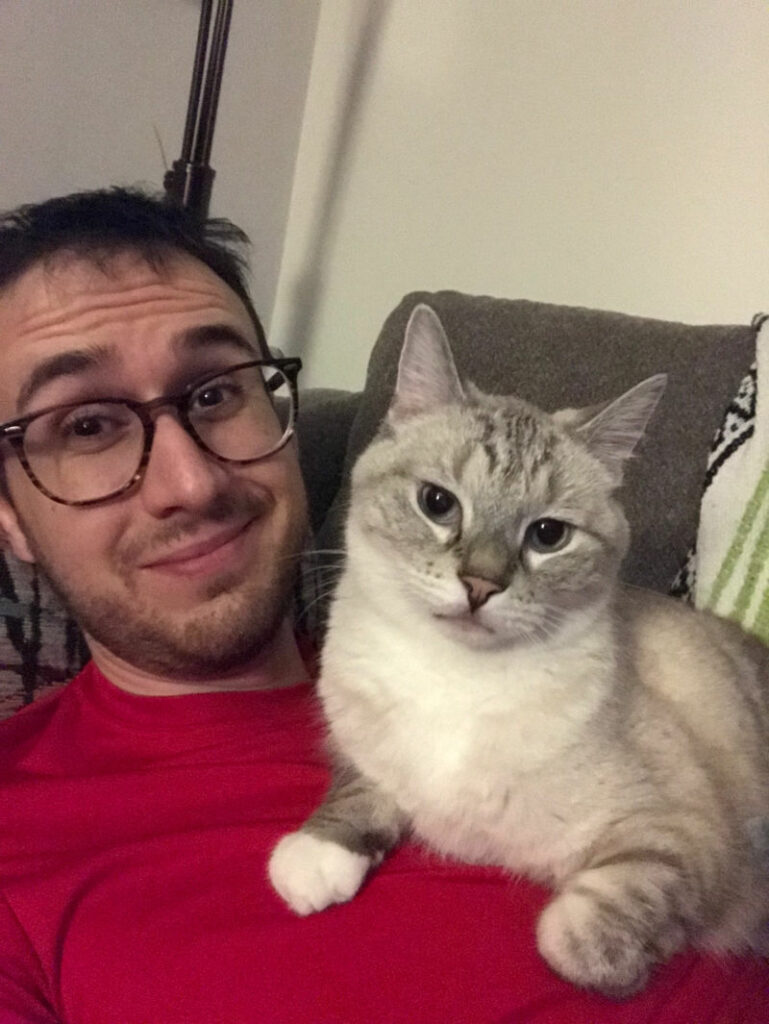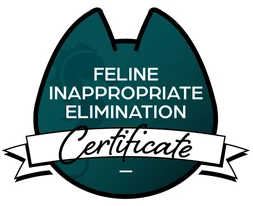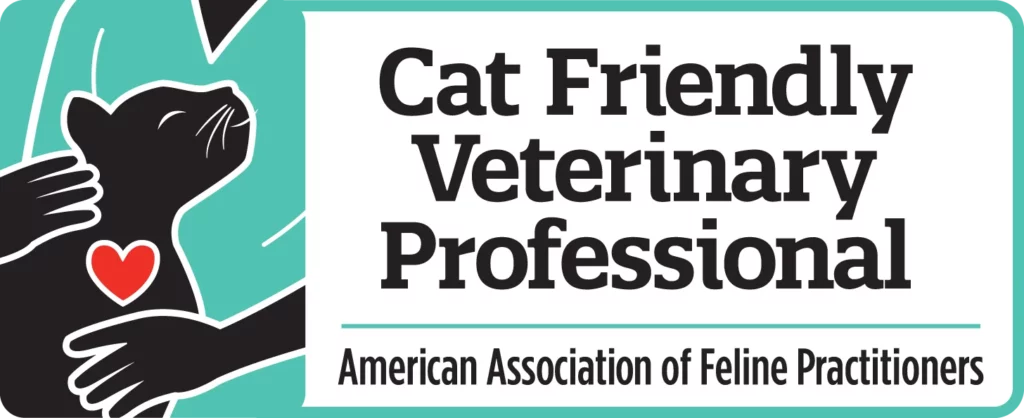I get asked a fair amount about how I got into cat behavior or how one gets started working with cats. I want to share the story of why I got started in cat behavior because I went through what a lot of my clients seem to be going through in that they’re lost, and not sure if there is any cat behavior help available.
While he is no longer with us, this story of course relates to Class Act Cats’ Chief Purr Officer, Zoloft. That cat had such a huge impact on my life and he continues to influence me and the world despite not being here. He was a special guy.

Early Training
When I first adopted Zoloft, I pretty quickly became interested in training him. Because I am far from perfect myself, I fell victim to bad advice on the internet that suggested I use a squirt bottle on him. I used it about 3 times and then felt so guilty about how scared he looked. I decided it wasn’t worth making him be afraid. Plus, it wasn’t even working so why bother?
I quickly discovered clicker training and ordered the basic supplies. When the clicker came, I trained Zoloft to do a high five in the first session. Now, I’m an amazing cat trainer but I really think the credit for how well that went goes to Zoloft. He was a smart guy, as Siamese cats are known for being, so it really was him who made it successful. Had I had a cat who was more challenging to train, you may not be here reading my blog post on how I became a cat behaviorist!
I thought that was pretty neat and continued casually training him. Looking back on it, after we began training high five, Zoloft began pawing at me when he wanted basically anything. I accidentally trained something called a default behavior. Knowing what I know now, it is pretty cool seeing that happen.
A Change In Behavior
While he was very special, any cat can have behavior problems if the situation is right. Zoloft was no exception to this despite usually being a velcro cat. That cat followed me everywhere. He was even known to watch me in the shower. He’d snuggle up tight and would want to be near me if he couldn’t be in my lap.
It was really weird when, in the fall of 2019, he began aggressing toward me. It started out as one night of him biting me while I was walking by and making a very sad-sounding meow. This was extremely unlike him, but I didn’t think too much of it at first other than thinking it was strange. It didn’t happen again right away so I moved on.
A Pattern Emerges
The exact timeline is a bit foggy at this point, but the behavior didn’t end up just happening once. As time went on, the aggressive behavior changed. Zoloft began following me around the apartment, tucking his tail in, meowing sadly, and then biting me. He would have his eyes fixated on me and would move slowly. Growls eventually were added into the mix.
The behavior become more and more frequent in addition to the concerning changes I noted. It started happening a few times a week to happening at least 4 nights out of the week. Often it would happen multiple days in a row.
The weird thing was that I began to notice that he was only doing it at night. During the day, he’d be his normal self. I distinctly remember one day during the worst of it when I was lying on the couch taking a nap because he was aggressing toward me more frequently. He jumped up and snuggled up on my chest as he always loved to do and like he did the second night he lived with me. I cried softly and asked him why he was being so sweet now, but at night he seemed so angry with me.
Human And Cat Behavior Changes
As it began to happen more frequently, I noted my behavior changing. I started carrying a blanket around to keep my cat away from me when he’d aggress toward me. I would also go to bed earlier or avoid getting up in the middle of the night. If I did, I’d have to see where Zoloft was first and would carry a pillow with me so I could get back into bed. When I’d go to bed, I’d quickly get into bed and cover myself up so he couldn’t get to me.
All this is to say that cat behavior affects human behavior and human behavior affects cat behavior. I began withdrawing from Zoloft and didn’t feel much like spending time with him at night in particular. During the day, I’d be more okay with being around him. When the sun began setting, I’d become very nervous. Even our nightly snugs would be scary.
Getting Help
Like many people, I turned to the internet at first to try to figure out what to do. I’m not opposed to advice on the internet as I clearly run a cat behavior blog, but it wasn’t all good. There were too many suggestions that didn’t sit right with me involving scaring my cat or doing things that didn’t seem like they’d help. I wanted to be gentle with him, especially as all the information I found online said he was being more defensively aggressive.
In other words, both of us were scared. I wasn’t doing well, he wasn’t doing well, nobody was having a good time!
I tried a few things like a Feliway diffuser (which helped slightly) and ignoring the behavior, but the behavior just didn’t improve enough.
One night, Zoloft was particularly relentless. It was close to Thanksgiving and I remember being so afraid. I had to get him into the bathroom after he wouldn’t leave me alone and he kept lunging at me. I remember crying in the dark, yelling at him through the door, and feeling so trapped. I had already concluded I didn’t want to rehome him as I loved him so much. I was worried if I did, he’d end up being euthanized. He was normally such a sweet cat… during the day.
Needless to say, it was not a high point of my life. I share it because I want you to know that if you’re overwhelmed by your cat’s behavior, I was there too. It wasn’t pretty, either.
A Vet Appointment Changed Things
I had heard of dog trainers but didn’t think there was anyone who could help cats. Even though I had actively been training my cat, it seemed like a for fun thing. It didn’t seem like it would be useful for something as severe as what I experienced. I did the only thing I could think of and scheduled an appointment with Zoloft’s veterinarian.
I didn’t realize it at the time, but that veterinarian appointment would be life-changing for both Zoloft and myself. It was about a month out, but I patiently waited and managed the behavior as best I could. During the appointment, we went over not only the behavior and potential medical explanations but also if there were any changes that had happened in my life recently. That led to us figuring out what happened.
I Was The Problem
The whole time this was happening, I was working a lot. I had a very stressful job and was starting to have feelings of not particularly enjoying the career path I had chosen. My job involved a lot of documentation and work outside of my traditional hours so I was often gone 10-12 hour days. I later realized I was incredibly burnt out.
This affected Zoloft because I was coming home late, feeding him, feeding myself, and basically going right to bed. Occasionally I’d have a pottery class, but that was outside the home. It was more time away from him. I was barely playing with him and on the weekends, I was very tired so I didn’t play with him a ton. I hadn’t realized how much my work was affecting how I interacted with him.
Finding Solutions
His vet came up with a plan that involved a combination of behavioral medication if needed and changing how I was interacting with him. This wasn’t part of her plan, but I also realized I needed to reduce my hours at work and focus on myself more. I made more time for Zoloft AND for me.
We talked about adding in food puzzles to add in more stimulation so I quickly bought a really cute one and a series of mice I could hide around the apartment.

I also played with Zoloft more and began clicker training him on a more serious level. The behavior began to improve with some time. We went back to being all snugs, no problems for three more wonderful years. Plus, I realized how much fun clicker training is! I’m forever grateful to Dr. O’Brien for making those suggestions.
Going Pro
Fast forward to the middle of the COVID pandemic. Burnout had set in again, but I was spending a lot of time with Zoloft and no behavior concerns arose again. I did decide that I needed to do something different career-wise. Whether or not I changed careers entirely, I realized things in my life needed to change.
I casually mentioned to a veterinarian friend that I wished I could do something to help cat parents who have cat behavior concerns without becoming a veterinarian and boy did she ever have the suggestion for me! She sent me information on the International Association of Animal Behavior Consultants, which I am now a certified cat behavior consultant through. I really looked into it and it became clear that this was the perfect direction for me to move.
I signed up for the IAABC Foundation’s Principles and Practice course and learned so much about animal behavior and cats. I also realized that coming from a background in human behavior, I already knew quite a lot more than I gave myself credit for. Cats are a different species than we are, but there’s a lot that is fundamentally the same across species. It was a natural transition.
Soon after completing that course and what seems like about a thousand others specifically on cats, I decided to jump in and start Class Act Cats. It has been a journey that has been filled with stress and challenges, but it feels so good to be able to help both cats and their humans. I love being able to do this and the challenges don’t even come close to the joy I get from seeing a cat turn around. I’m so grateful to Drs. Hart and O’Brien and, most importantly, Zoloft for unknowingly sending me on this journey.
If you’re struggling with what to do with your cat’s behavior, you may be feeling a lot like I did when I wasn’t sure what to do: scared, confused, frustrated, or at your wit’s end. The good news is that I’m here to help! If you want personalized advice about your cat’s behavior, set up a consultation so we can figure out how to get you back to loving your kitty!










